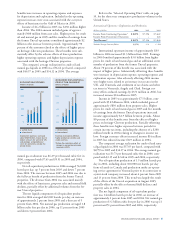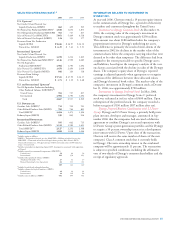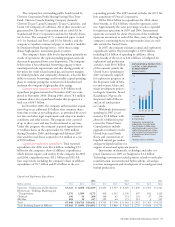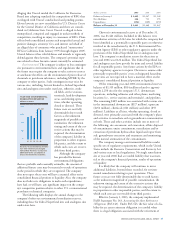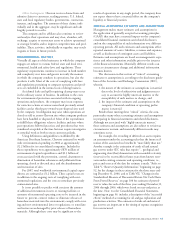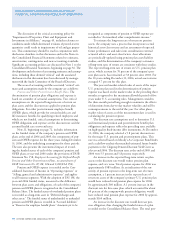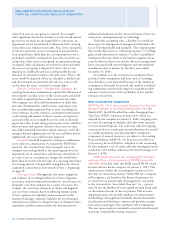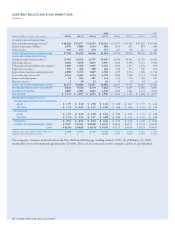Chevron 2006 Annual Report Download - page 42
Download and view the complete annual report
Please find page 42 of the 2006 Chevron annual report below. You can navigate through the pages in the report by either clicking on the pages listed below, or by using the keyword search tool below to find specific information within the annual report.
MANAGEMENT’S DISCUSSION AND ANALYSIS OF
FINANCIAL CONDITION AND RESULTS OF OPERATIONS
40 CHEVRON CORPORATION 2006 ANNUAL REPORT
Control group to ensure compliance with the company’s risk
management policies that have been approved by the Audit
Committee of the company’s Board of Directors.
The derivative instruments used in the company’s risk
management and trading activities consist mainly of futures,
options, and swap contracts traded on the NYMEX (New
York Mercantile Exchange) and on electronic platforms of
ICE (Inter-Continental Exchange) and GLOBEX (Chicago
Mercantile Exchange). In addition, crude oil, natural gas
and refi ned product swap contracts and option contracts are
entered into principally with major fi nancial institutions and
other oil and gas companies in the “over-the-counter” markets.
Virtually all derivatives beyond those designated as nor-
mal purchase and normal sale contracts are recorded at fair
value on the Consolidated Balance Sheet with resulting gains
and losses refl ected in income. Fair values are derived prin-
cipally from published market quotes and other independent
third-party quotes.
Each hypothetical 10 percent increase in the price of
natural gas, crude oil and refi ned products would increase
the fair value of the natural gas purchase derivative contracts
by approximately $10 million, increase the fair value of the
crude oil purchase derivative contracts by about $4 million
and reduce the fair value of the refi ned product sale deriva-
tive contracts by about $30 million, respectively. The same
hypothetical decrease in the prices of these commodities
would result in approximately the same opposite effects on
the fair values of the contracts.
The hypothetical effect on these contracts was estimated
by calculating the fair value of the contracts as the difference
between the hypothetical and current market prices multi-
plied by the contract amounts.
Foreign Currency The company enters into forward
exchange contracts, generally with terms of 180 days or less,
to manage some of its foreign currency exposures. These expo-
sures include revenue and anticipated purchase transactions,
including foreign currency capital expenditures and lease com-
mitments, forecasted to occur within 180 days. The forward
exchange contracts are recorded at fair value on the balance
sheet with resulting gains and losses refl ected in income.
The aggregate effect of a hypothetical 10 percent
increase in the value of the U.S. dollar at year-end 2006
would be a reduction in the fair value of the foreign exchange
contracts of approximately $40 million. The effect would
be the opposite for a hypothetical 10 percent decrease in the
year-end value of the U.S. dollar.
Interest Rates The company enters into interest rate
swaps as part of its overall strategy to manage the interest
rate risk on its debt. Under the terms of the swaps, net cash
settlements are based on the difference between fi xed-rate
and fl oating-rate interest amounts calculated by reference to
agreed notional principal amounts. Interest rate swaps related
to a portion of the company’s fi xed-rate debt are accounted
for as fair value hedges, whereas interest rate swaps related to
a portion of the company’s fl oating-rate debt are recorded at
fair value on the balance sheet with resulting gains and losses
refl ected in income.
At year-end 2006, the weighted average maturity of
“receive fi xed” interest rate swaps was approximately one
year. There were no “receive fl oating” swaps outstanding at
year end. A hypothetical increase of 10 basis points in fi xed
interest rates would reduce the fair value of the “receive
fi xed” swaps by approximately $2 million.
For the fi nancial and derivative instruments discussed
above, there was not a material change in market risk
between 2006 and 2005.
The hypothetical variances used in this section were
selected for illustrative purposes only and do not represent
the company’s estimation of market changes. The actual
impact of future market changes could differ materially due
to factors discussed elsewhere in this report, including those
set forth under the heading “Risk Factors” in Part I, Item 1A,
of the company’s 2006 Annual Report on Form 10-K.
TRANSACTIONS WITH RELATED PARTIES
Chevron enters into a number of business arrangements
with related parties, principally its equity affi liates. These
arrangements include long-term supply or offtake agree-
ments. Long-term purchase agreements are in place with the
company’s refi ning affi liate in Thailand. Refer to page 39
for further discussion. Management believes the foregoing
agreements and others have been negotiated on terms con-
sistent with those that would have been negotiated with an
unrelated party.
LITIGATION AND OTHER CONTINGENCIES
MTBE Chevron and many other companies in the petro-
leum industry have used methyl tertiary butyl ether (MTBE)
as a gasoline additive. Chevron is a party to approximately 75
lawsuits and claims, the majority of which involve numerous
other petroleum marketers and refi ners, related to the use of
MTBE in certain oxygenated gasolines and the alleged seep-
age of MTBE into groundwater. Resolution of these actions
may ultimately require the company to correct or ameliorate
the alleged effects on the environment of prior release of
MTBE by the company or other parties. Additional lawsuits
and claims related to the use of MTBE, including personal-
injury claims, may be fi led in the future.
The company’s ultimate exposure related to these law-
suits and claims is not currently determinable, but could be
material to net income in any one period. The company cur-
rently does not use MTBE in the manufacture of gasoline in
the United States.
RFG Patent Fourteen purported class actions were
brought by consumers of reformulated gasoline (RFG)



